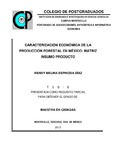Caracterización económica de la producción forestal en México: Matriz Insumo Producto
Abstract
El sector forestal es importante para la sociedad por los productos que genera, los servicios de recreación y turismo y los elementos ecológicos que le dan soporte a los ecosistemas. Por lo anterior se hace imperativo analizar el papel económico del sector forestal en su interrelación con las demás ramas económicas del país y las perspectivas futuras de este sector. En el análisis se utilizó la matriz Insumo-Producto de 2012, compuesta por 259 ramas de actividad económica; en las cuales se desagregó el sector agropecuario, y en éste las ramas del subsector forestal (Silvicultura, Viveros forestales, Recolección de productos forestales y Tala de árboles). Otras ramas como la industria manufacturera se agregaron, manejándose, en total una matriz de 14 sectores. Con base en el crecimiento poblacional se crearon escenarios de comportamiento del sector forestal para los años 2015, 2020, 2025 y 2030. Los resultados mostraran que la contribución del sector forestal, seguirá siendo, reducida, apenas de 0.075% del Valor Bruto de la Producción nacional, aunque tendrá tasas de crecimiento positivas para los años considerados, sin embargo, la balanza comercial de productos forestales seguirá siendo deficitaria. _______________ ECONOMIC CHARACTERISTICS OF FOREST PRODUCTION IN MEXICO: INPUT-OUTPUT MATRIX. ABSTRACT: The forestry sector is important to society because of the products that it generates, recreation and tourism services, and the ecological elements that support the ecosystem. Because of this, it is imperative to analyze the economic role of the forestry sector in its interrelation with the other economic branches in the country and the future perspectives of this sector. For the analysis, the 2012 Input-Product matrix was used, made up of 259 branches of economic activity. From this matrix, the farm and livestock sector was disaggregated, and from this last one, the branches of the forestry sub-sector (Silviculture, Forest nurseries, Collection of forest products, and Lumbering). Other branches like the manufacturing industry were added to give rise to a working matrix of 14 sectors in total. Based on population growth, scenarios were created to forecast the behavior of the forestry sector for the years 2015, 2020, 2025, and 2030. The results show that the contribution of the forestry sector will continue to be reduced, reaching only 0.075% of the Gross domestic product (GDP). Although there will be positive growth rates for the years considered, the commercial balance of forest products will continue to be deficient.
Collections
- Tesis MC, MT, MP y DC [263]


